5修辞与翻译(1)
- 格式:ppt
- 大小:339.01 KB
- 文档页数:49

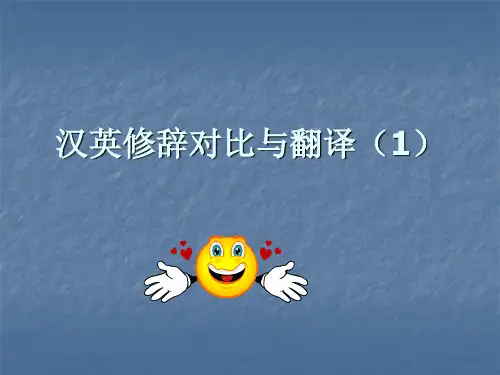
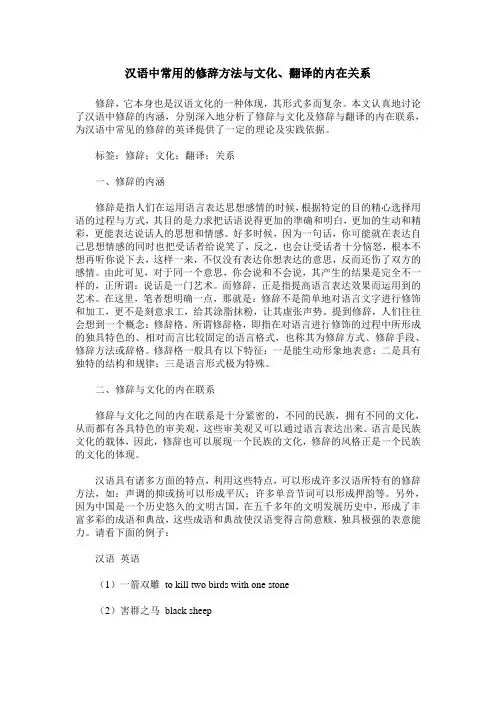
汉语中常用的修辞方法与文化、翻译的内在关系修辞,它本身也是汉语文化的一种体现,其形式多而复杂。
本文认真地讨论了汉语中修辞的内涵,分别深入地分析了修辞与文化及修辞与翻译的内在联系,为汉语中常见的修辞的英译提供了一定的理论及实践依据。
标签:修辞;文化;翻译;关系一、修辞的内涵修辞是指人们在运用语言表达思想感情的时候,根据特定的目的精心选择用语的过程与方式,其目的是力求把话语说得更加的準确和明白,更加的生动和精彩,更能表达说话人的思想和情感。
好多时候,因为一句话,你可能就在表达自己思想情感的同时也把受话者给说笑了,反之,也会让受话者十分恼怒,根本不想再听你说下去,这样一来,不仅没有表达你想表达的意思,反而还伤了双方的感情。
由此可见,对于同一个意思,你会说和不会说,其产生的结果是完全不一样的,正所谓:说话是一门艺术。
而修辞,正是指提高语言表达效果而运用到的艺术。
在这里,笔者想明确一点,那就是:修辞不是简单地对语言文字进行修饰和加工,更不是刻意求工,给其涂脂抹粉,让其虚张声势。
提到修辞,人们往往会想到一个概念:修辞格。
所谓修辞格,即指在对语言进行修饰的过程中所形成的独具特色的、相对而言比较固定的语言格式,也称其为修辞方式、修辞手段、修辞方法或辞格。
修辞格一般具有以下特征:一是能生动形象地表意;二是具有独特的结构和规律;三是语言形式极为特殊。
二、修辞与文化的内在联系修辞与文化之间的内在联系是十分紧密的,不同的民族,拥有不同的文化,从而都有各具特色的审美观,这些审美观又可以通过语言表达出来。
语言是民族文化的载体,因此,修辞也可以展现一个民族的文化,修辞的风格正是一个民族的文化的体现。
汉语具有诸多方面的特点,利用这些特点,可以形成许多汉语所特有的修辞方法,如:声调的抑或扬可以形成平仄;许多单音节词可以形成押韵等。
另外,因为中国是一个历史悠久的文明古国,在五千多年的文明发展历史中,形成了丰富多彩的成语和典故,这些成语和典故使汉语变得言简意赅,独具极强的表意能力。
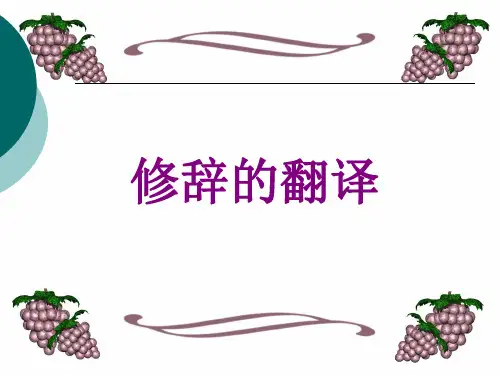
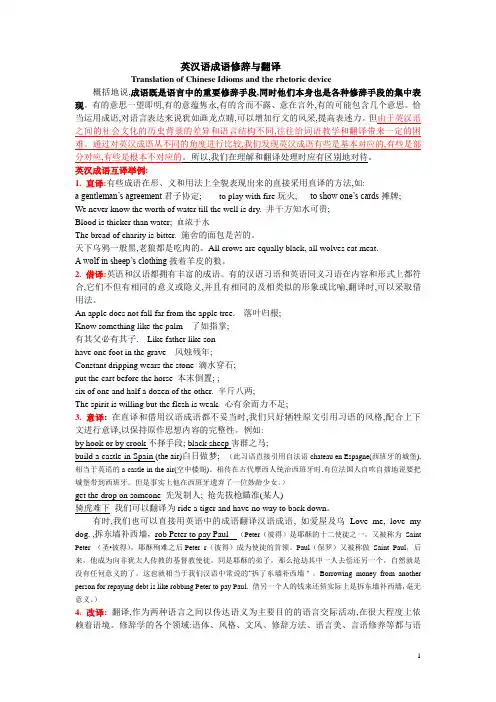
英汉语成语修辞与翻译Translation of Chinese Idioms and the rhetoric device概括地说,成语既是语言中的重要修辞手段,同时他们本身也是各种修辞手段的集中表现。
有的意思一望即明,有的意蕴隽永,有的含而不露、意在言外,有的可能包含几个意思。
恰当运用成语,对语言表达来说犹如画龙点睛,可以增加行文的风采,提高表述力。
但由于英汉语之间的社会文化的历史背景的差异和语言结构不同,往往给词语教学和翻译带来一定的困难。
通过对英汉成语从不同的角度进行比较,我们发现英汉成语有些是基本对应的,有些是部分对应,有些是根本不对应的。
所以,我们在理解和翻译处理时应有区别地对待。
英汉成语互译举例:1. 直译:有些成语在形、义和用法上全貌表现出来的直接采用直译的方法,如:a gentleman’s agreement君子协定; to play with fire玩火, to show one’s cards摊牌;We never know the worth of water till the well is dry. 井干方知水可贵;Blood is thicker than water; 血浓于水The bread of charity is bitter. 施舍的面包是苦的。
天下乌鸦一般黑,老狼都是吃肉的。
All crows are equally black, all wolves eat meat.A wolf in sheep’s clothing披着羊皮的狼。
2. 借译:英语和汉语都拥有丰富的成语。
有的汉语习语和英语同义习语在内容和形式上都符合,它们不但有相同的意义或隐义,并且有相同的及相类似的形象或比喻,翻译时,可以采取借用法。
An apple does not fall far from the apple tree. 落叶归根;Know something like the palm 了如指掌;有其父必有其子. Like father like sonhave one foot in the grave 风烛残年;Constant dripping wears the stone 滴水穿石;put the cart before the horse 本末倒置; ;six of one and half a dozen of the other. 半斤八两;The spirit is willing but the flesh is weak. 心有余而力不足;3. 意译: 在直译和借用汉语成语都不妥当时,我们只好牺牲原文引用习语的风格,配合上下文进行意译,以保持原作思想内容的完整性。
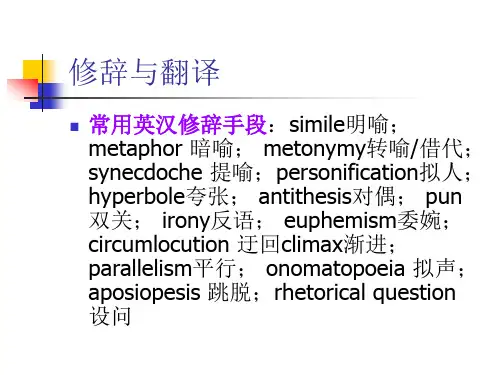
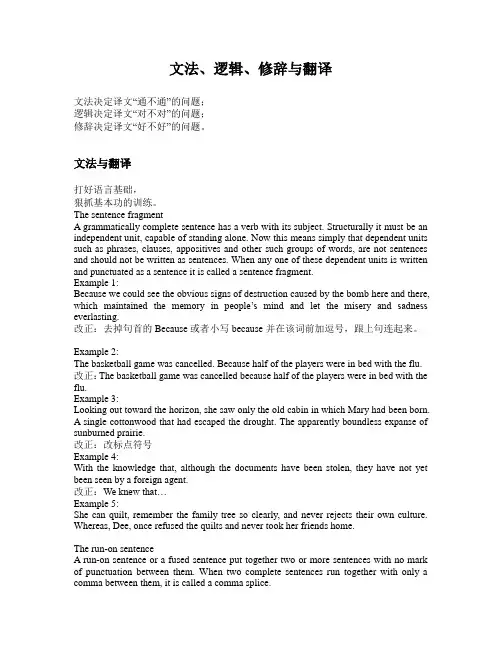
文法、逻辑、修辞与翻译文法决定译文“通不通”的问题;逻辑决定译文“对不对”的问题;修辞决定译文“好不好”的问题。
文法与翻译打好语言基础,狠抓基本功的训练。
The sentence fragmentA grammatically complete sentence has a verb with its subject. Structurally it must be an independent unit, capable of standing alone. Now this means simply that dependent units such as phrases, clauses, appositives and other such groups of words, are not sentences and should not be written as sentences. When any one of these dependent units is written and punctuated as a sentence it is called a sentence fragment.Example 1:Because we could see the obvious signs of destruction caused by the bomb here and there, which maintained the memory in people’s mind and let the misery and sadness everlasting.改正:去掉句首的Because或者小写because并在该词前加逗号,跟上句连起来。
Example 2:The basketball game was cancelled. Because half of the players were in bed with the flu. 改正:The basketball game was cancelled because half of the players were in bed with the flu.Example 3:Looking out toward the horizon, she saw only the old cabin in which Mary had been born.A single cottonwood that had escaped the drought. The apparently boundless expanse of sunburned prairie.改正:改标点符号Example 4:With the knowledge that, although the documents have been stolen, they have not yet been seen by a foreign agent.改正:We knew that…Example 5:She can quilt, remember the family tree so clearly, and never rejects their own culture. Whereas, Dee, once refused the quilts and never took her friends home.The run-on sentenceA run-on sentence or a fused sentence put together two or more sentences with no mark of punctuation between them. When two complete sentences run together with only a comma between them, it is called a comma splice.Example 1:In Hiro shima, people don’t want to mention the very thing, such as, you will have a pain in a scar that hasn’t healed completely, if someone touch it.改正:Example 2:Kimonos and miniskirts mixed in this city, and the traditional Japanese house and modern skyscrapers also co-exist in this city, they show that Hiroshima is thriving and developing rapidlyExample 3:However, she is lack of education, she is lack of confidence, she represents the bottom class people in the society.Example 4:She is lack of education and refinement, however, those does not prevent her from having an inherent understanding of heritage based on her love and respect for those who came before her.Example 5:These snakes are dangerous however, most snakes are quite harmless.改正:Example 6:The pollution became strategic and started to affect our human living, now we have to face the consequences.后置、前置、倒装“主语+谓语” 词序:word order英语的“正常词序”(normal order)或“自然词序”(natural order)除状语位置比较机动外,主语、谓语动词、宾语和补语的位置都是相对固定的。

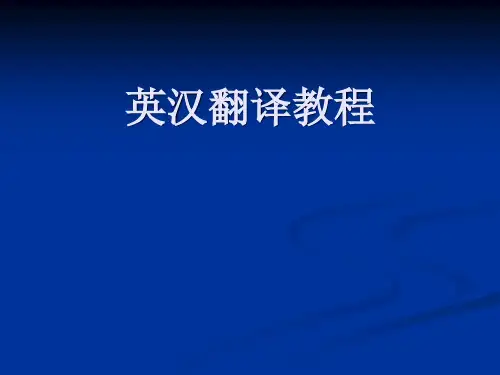

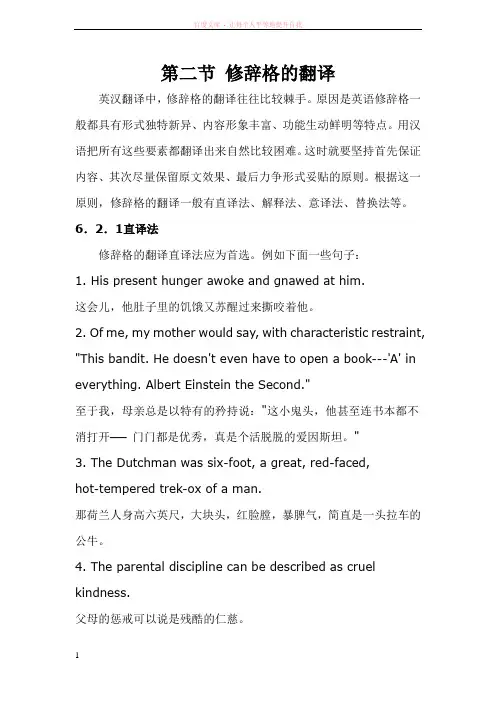
第二节修辞格的翻译英汉翻译中,修辞格的翻译往往比较棘手。
原因是英语修辞格一般都具有形式独特新异、内容形象丰富、功能生动鲜明等特点。
用汉语把所有这些要素都翻译出来自然比较困难。
这时就要坚持首先保证内容、其次尽量保留原文效果、最后力争形式妥贴的原则。
根据这一原则,修辞格的翻译一般有直译法、解释法、意译法、替换法等。
6.2.1直译法修辞格的翻译直译法应为首选。
例如下面一些句子:1. His present hunger awoke and gnawed at him.这会儿,他肚子里的饥饿又苏醒过来撕咬着他。
2. Of me, my mother would say, with characteristic restraint, "This bandit. He doesn't even have to open a book---'A' in everything. Albert Einstein the Second."至于我,母亲总是以特有的矜持说:"这小鬼头,他甚至连书本都不消打开──门门都是优秀,真是个活脱脱的爱因斯坦。
"3. The Dutchman was six-foot, a great, red-faced,hot-tempered trek-ox of a man.那荷兰人身高六英尺,大块头,红脸膛,暴脾气,简直是一头拉车的公牛。
4. The parental discipline can be described as cruel kindness.父母的惩戒可以说是残酷的仁慈。
5. Safety will be the sturdy child of terror, and survival the twin brother of annihilation.安全是恐怖的健壮婴儿,生存是毁灭的孪生兄弟。
6. The plays adapted from Greek tragedies and Shakespearean drama by Suzuki, although performed in Japanese, caused a big stir among the western audience with their strange and cruel beauty.铃木正改编自希腊悲剧和莎士比亚戏剧的剧作,虽然以日语演出,但那种奇异而残酷的美,却在西方观众中引起了轰动。
英语修辞手法总结Figures of speech (修辞)are ways of making our language figurative. When we use words in other than their ordinary or literal sense to lend force to an idea, to heighten effect, or to create suggestive imagery, we are said to be speaking or writing figuratively. Now we are going to talk about some common forms of figures of speech.1) Simile:(明喻〕It is a figure of speech which makes a comparison between two unlike elements having at least one quality or characteristic (特性)in common. To make the comparison, words like as, as...as, as if and like are used to transfer the quality we associate with one to the other. For example, As cold waters to a thirsty soul, so is good news from a far country.2) Metaphor:(暗喻〕It is like a simile, also makes a comparison between two unlike elements, but unlike a simile, this comparison is implied rather than stated. For example, the world is a stage.3) Analogy: (类比〕It is also a form of comparison, but unlike simile or metaphor which usually uses comparison on one point of resemblance, analogy draws a parallel between two unlike things that have several common qualities or points of resemblance.4) Personification: (拟人〕It gives human form of feelings to animals, or life and personal attributes(赋予) to inanimate(无生命的) objects, or to ideas and abstractions(抽象). For example, the wind whistled through the trees.5) Hyperbole: (夸大〕 It is the deliberate use of overstatement or exaggeration to achieve emphasis. For instance, he almost died laughing.6) Understatement: (含蓄陈述〕 It is the opposite of hyperbole, or overstatement. It achieves its effect of emphasizing a fact by deliberately(成心地) understating it, impressing the listener or the reader more by what is merely implied or left unsaid than by bare statement. For instance, It is no laughing matter.7) Euphemism: (委婉〕 It is the substitution of an agreeable or inoffensive(无冒犯) expression for one that may offend or suggest something unpleasant. For instance, we refer to "die" as " pass away".8) Metonymy (转喻〕It is a figure of speech that has to do with the substitution of the mane of one thing for that of another. For instance, the pen (words) is mightier than the sword (forces).9) Synecdoche (提喻〕 It is involves the substitution of the part for the whole, or thewhole for the part. For instance, they say there's bread and work for all. She was dressed in silks.10) Antonomasia (换喻〕It has also to do with substitution. It is not often mentioned now, though it is still in frequent use. For example, Solomon for a wise man. Daniel for a wise and fair judge. Judas for a traitor.11) Pun: (双关语〕 It is a play on words, or rather a play on the form and meaning of words. For instance, a cannon-ball took off his legs, so he laid down his arms. (Here "arms" has two meanings: a person's body; weapons carried by a soldier.)12) Syllepsis: (一语双叙〕 It has two connotations.In the first case, it is a figure by which a word, or a particular form or inflection of a word, refers to two or more words in the same sentence, while properly applying to or agreeing with only on of them in grammar or syntax(句法). For example, He addressed you and me, and desired us to follow him. (Here us is used to refer to you and me.)In the second case, it a word may refer to two or more words in the same sentence. For example, while he was fighting , and losing limb and mind, and dying, others stayed behind to pursue education and career. (Here to losingone's limbs in literal; to lose one's mind is figurative, and means to go mad.)13) Zeugma: (轭式搭配〕 It is a single word which is made to modify or to govern two or more words in the same sentence, wither properly applying in sense to only one of them, or applying to them in different senses. For example, The sun shall not burn you by day, nor the moon by night. (Here noon is not strong enough to burn)14) Irony: (反语〕 It is a figure of speech that achieves emphasis by saying the opposite of what is meant, the intended meaning of the words being the oppositeof their usual sense. For instance, we are lucky, what you said makes me feel real good.15) Innuendo: (暗讽〕 It is a mild form of irony, hinting in a rather roundabout (曲折)way at something disparaging(不一致) or uncomplimentary(不赞美) to the person or subject mentioned. For example, the weatherman said it would be worm. He must take his readings in a bathroom.16) Sarcasm: (挖苦〕 It Sarcasm is a strong form of irony. It attacks in a taunting and bitter manner, and its aim is to disparage, ridicule and wound the feelings of the subject attacked. For example, laws are like cobwebs, which may catch small flies, but let wasps break through.17) Paradox: (似非而是的隽语〕 It is a figure of speech consisting of a statementor proposition which on the face of it seems self-contradictory, absurd or contrary to established fact or practice, but which on further thinking and study may prove to be true, well-founded, and even to contain a succinct point. For example more haste, less speed.18) Oxymoron: (矛盾修饰〕 It is a compressed paradox, formed by the conjoining(结合) of two contrasting, contradictory or incongruous(不协调) terms as in bitter-sweet memories, orderly chaos(混乱) and proud humility(侮辱).19) Antithesis: (对照〕 It is the deliberate arrangement of contrasting words or ideas in balanced structural forms to achieve emphasis. For example, speech is silver; silence is golden.20) Epigram: (警句〕 It states a simple truth pithily(有利地) and pungently(强烈地). It is usually terse and arouses interest and surprise by its deep insight into certain aspects of human behavior or feeling. For instance, Few, save the poor, feel for the poor.21) Climax: (渐进〕 It is derived from the Greek word for "ladder" and implies the progression of thought at a uniform or almost uniform rate of significance or intensity, like the steps of a ladder ascending evenly. For example, I came, I saw,I conquered.22) Anti-climax or bathos: (突降〕It is the opposite of Climax. It involves stating one's thoughts in a descending order of significance or intensity, from strong toweak, from weighty to light or frivolous. For instance, But thousands die, without or this or that, die, and endow(赋予) a college, or a cat.23) Apostrophe: (顿呼〕 In this figure of speech, a thing, place, idea or person (dead or absent) is addressed as if present, listening and understanding what is being said. For instance, England! awake! awake! awake!24) Transferred Epithet: (转类形容词〕 It is a figure of speech where an epithet (an adjective or descriptive phrase) is transferred from the noun it should rightly modify(修饰) to another to which it does not really apply or belong. For instance,I spent sleepless nights on my project.25) Alliteration: (头韵〕 It has to do with the sound rather than the sense of words for effect. It is a device that repeats the same sound at frequentintervals(间隔) and since the sound repeated is usually the initial consonant sound, it is also called "front rhyme". For instance, the fair breeze blew, the white foam flew, the furrow followed free.26) Onomatopoeia: (拟声〕 It is a device that uses words which imitate the sounds made by an object (animate or inanimate), or which are associated with or suggestive(提示的) of some action or movementExplanation version1一、什么是修辞格修辞格(figures of speech)是提高语言表达效果的语言艺术。
文言文常见修辞的翻译班级姓名 _________________一、比喻的翻译1、明喻仍译为明喻。
古文中的明喻一般与现代汉语的使用习惯相同,所以直译就行了。
例:(1)皆玄衣白刃,剽疾如猿猴。
(《冯婉真》)译文:“像猿猴一样剽悍敏捷”。
(2)火烈风猛,船往如箭。
(《赤壁之战》)译文:“船像箭一样往前冲”。
2、暗喻用了比喻词的,仍译为暗喻不用比喻词的,译为明喻。
例:(1)如今人方为刀俎,我为鱼肉。
译文:现在人家是刀和砧板,我们是鱼和肉。
(2)古来万事东流水。
译文:自古以来万事都像东去的流水一样。
(3)夫秦王有虎狼之心。
译文:秦王有像虎狼一样凶狠的心肠。
3、借喻译为它所比喻的事物,即把喻体还原成本体。
例:(1)北筑长城而守藩篱。
《过秦论》译文:在北边筑起长城来把守边疆。
(2)误落尘网中,一去三十年。
《归园田居》译文:误入污浊的官场,一误就是三十年。
二、借代的翻译古今汉语在借代的使用上差别很大,如果把借代直译过来,会让人感到不易理解和接受,所以借代应意译,译为它所代替的人或物。
1、肉食者鄙,未能远谋。
《曹刿论战》译文:做官的人见识浅陋,不能做长远的打算。
2、意北亦尚可以口舌动也。
《指南录后序》译文:考虑到元军也许还能够用言语来打动。
3、大阉亦逡巡畏义,非常之谋难于猝发。
译文:魏忠贤也迟疑不决,害怕正义,篡位的阴谋难于立刻发动。
4、沛公不胜杯杓,不能辞。
《鸿门宴》译文:沛公承受不住酒力,不能前来告辞。
5、洎牧以谗诛,邯郸为郡。
《六国论》译文:等到李牧因为谗言被杀害,赵国成了秦国的一个郡。
三、夸张的翻译1、状态、程度方面的夸张,仍译为夸张,前面加上“像要”或“快要”。
例:(1)相如因持璧却立,倚柱,怒发上冲冠。
《廉颇蔺相如列传》译文:蔺相如于是拿着和氏壁退后站在那里,靠在柱子上,愤怒得头发像要顶起帽子。
(2)成顾蟋蟀笼虚,则气断声吞。
《促织》译文:成名回头看到蟋蟀笼空着,就急得快要出不来气,说不出话。
2、数量方面的夸张,可把数量词换成表示“多”“高”“大”等副词、形容词例:军书十二卷,卷卷有爷名。